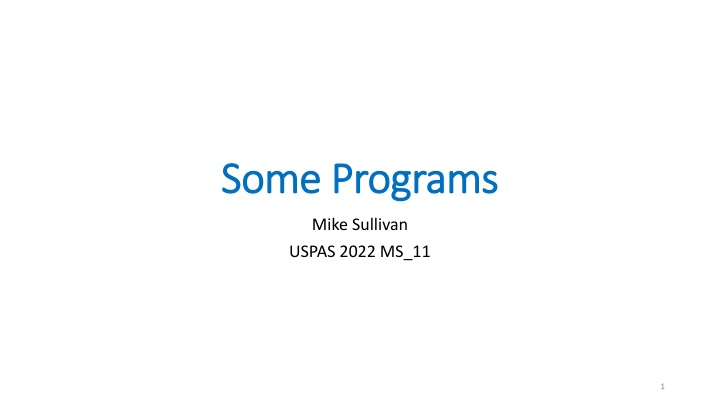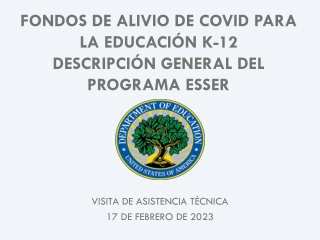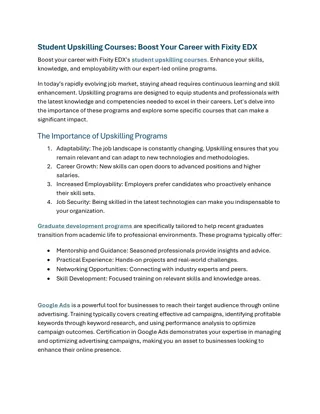
Studying Synchrotron Radiation with Program SYNC_BKG
In the realm of synchrotron radiation research, a program named SYNC_BKG proves to be a valuable tool. Developed long ago and continuously upgraded, this program efficiently calculates background radiation rates, utilizing a straightforward approach for estimating and verifying results. By parsing input data regarding beam characteristics, magnet properties, and aperture details, SYNC_BKG simulates the radiation generation process and provides a detailed output, aiding in the design of effective masking schemes within a short timeframe. This program, written in FORTRAN, reads ASCII files and generates insightful reports on the photon interactions with beam pipe surfaces, offering essential information on photon origins and energy distribution.
Download Presentation

Please find below an Image/Link to download the presentation.
The content on the website is provided AS IS for your information and personal use only. It may not be sold, licensed, or shared on other websites without obtaining consent from the author. If you encounter any issues during the download, it is possible that the publisher has removed the file from their server.
You are allowed to download the files provided on this website for personal or commercial use, subject to the condition that they are used lawfully. All files are the property of their respective owners.
The content on the website is provided AS IS for your information and personal use only. It may not be sold, licensed, or shared on other websites without obtaining consent from the author.
E N D
Presentation Transcript
Some Programs Some Programs Mike Sullivan USPAS 2022 MS_11 1
Programs Programs I hope I have shown you that synchrotron radiation from bend magnets can be studied using some fairly simple formulas These formulas are very useful in that they allow you to cross-check any program output. Sometimes you need to setup the program to do a simple problem that you can check against. Quadrupole radiation can be crudely estimated but it really needs a program to effectively calculate background rates One can make some estimates using the beam-stay-clear envelope to see if a particular masking scheme will work but even then, it would only be a first guess For most of my work, I use a program I have inherited from Al Clark of LBNL who built the main code in the mid 1980s This program has been upgraded by several people (including myself) to have the following: 1) non-gaussian beam-tails; 2) bend magnets; 3) position offsets in the magnet locations; 4) non-zero angle in the magnet orientation wrt to the beam 2
SYNC_BKG SYNC_BKG I have named my version of the program SYNC_BKG. Because it was made so long ago, it is now very fast (a run usually takes 1-2 sec on my laptop) The program code is simple FORTRAN and hence is very portable It reads in an ASCII file of information about the number of particles in each bunch, number of bunches, ring freq., beam energy, non-gaussian tail parameters, magnet information (location, length, strength), and finally a list of transverse apertures that describe the beam pipe The apertures are usually circles or ellipses, but it also accepts horizontal and vertical slits The magnets can be split into several sections to more accurately trace the beam particle trajectories A typical run includes ~20 magnetic elements and ~100 apertures A run scans the transverse beam profile out to usually 15 sigmas or more in steps of 0.25 sigma on an XY grid (double DO LOOP) It propagates a weighted macro particle through the magnetic fields generating a fan of radiation for each magnetic element and extrapolates the fan onto the beam pipe apertures tallying up the critical energy of the fan into a weighted histogram of critical energies for each aperture When the double loop through the transverse beam scan finishes the weighted histogram for each aperture is finally converted into a table of values (number of photons above a certain energy) 3
SYNC_BKG (2) SYNC_BKG (2) Once this is all done the information is printed out in an ASCII file and it includes information as to which magnetic elements contributed to the photon hits for each aperture as well as a summary of where the photons originated with respect to the transverse beam profile The program is very useful when the design of the beampipe is not yet final, and it gives the user a rapid turn around in order to design an effective masking scheme design in a short amount of time This program does not generate individual photons, but it tells the user how many photons strike a particular surface of the beam pipe as well as some information about the energy spectrum 4
SYNRAD SYNRAD A more recent program has come forward in the last 10 years called SYNRAD. It originated in the mid 90s to study SR for the SSC. It now comes from CERN and can be downloaded from the CERN site. This program is much more sophisticated, and it can read in files of information about the magnetic lattice from MADX and other lattice programs It can also read in information about the beam pipe from various CAD programs It generates and propagates individual photons from SR by a single beam particle by sampling from the transverse beam distribution It tallies the number of photons striking the surfaces of the beam pipe and can scatter or absorb these photons 5
SYNRAD (2) SYNRAD (2) SYNRAD and SYNRAD+ can be used to study beam pipes without CAD files by letting the user input various beam pipe designs directly This particular program is useful in calculating the outgassing effects from SR photons and together with MOFLOW, a program to calculate gas pressures based on vacuum pump locations one can get an estimate of the actual gas pressure in a specific location of the beam pipe This information is very important for beam-gas background calculations which we will discuss next File web site for SYNRAD and MOFLOW: https://molflow.web.cern.ch/sites/molflow.web.cern.ch/files/ 6
Beam Beam- -gas (BGB and Coulomb) programs gas (BGB and Coulomb) programs This background has been studied using several different programs An early program called DECAY TURTLE (Trace Unlimited Rays Through Lumped Elements) (they must have worked hard to get this acronym!) Put together by FermiLab, SLAC and CERN in 1982 The Decay version of Turtle can follow the daughters of a decay process This was designed for beam particles that actually do decay (e.g. muon, pion beams) but with a minor modification it can also work for an interaction where the initial particle is one of the decay particles as in beam-gas and Coulomb scattering This modification to enable BGB and Coulomb scattering was implemented with version TUR105. All higher versions also have this option. 7
DECAY TURTLE DECAY TURTLE I have some knowledge of this code and the initial writeup is in the SLAC preprint library (SLAC-R-246) The code is in FORTRAN and gets input by reading an ASCII file and also writes out an ASCII output file Once again, this was written a while back and hence is very fast It includes higher-order chromatic aberrations, effects of non-linearities in magnetic fields, and higher-order geometric aberrations due to the accumulation of second-order effects quote from the above writeup Not sure it is being used these days anymore It can generate the interactions and it traces the daughter particles to user defined beam pipe apertures, but it has no capability of tracing the particles through materials 8
GEANT4 GEANT4 GEANT4 (GEometry ANd Tracking) is a general program for tracking particles through matter Supported by CERN and it also supports many generating codes for the initiation of an interaction This includes BGB and Coulomb as well as physics events and luminosity events (Bhabhas and radiative Bhabhas) Primarily used for detector simulation including the beam pipe and accelerator components inside and near the detector Although it can do the particle tracking, it is somewhat cumbersome to use as a model for an entire storage ring GEANT4 web site: https://geant4.web.cern.ch/node/1 9
FLUKA FLUKA FLUKA (FLUktuierende KAskade) (fluctuating cascade) is another code for tracking particles through matter It started as code specializing in nuclear interactions from hadron beams and has developed into a more general particle tracking code FLUKA and GEANT4 have been compared and they do produce similar results As far as I know, both of these programs need generator code to create the particles for tracking They both have many internal generators, but I am not sure they have generator code for BGB and Coulomb interactions for an electron beam FLUKA web site: http://www.fluka.org/fluka.php 10
MARS15 MARS15 Nikolai has presented many slides on MARS15 It looks like a very good package that can be compared with either GEANT4 and FLUKA and may even have more flexibility All three codes generate single particle events that are then tracked through the specified geometries, specified materials and specified magnetic fields All three codes can be paralleled, and an initialized setup can be submitted to a compute farm for maximum statistics https://inspirehep.net/files/21a1f216d472b608551aac7bf4bdd556 This is a writeup by Nikolai about MARS15 11
SAD SAD SAD (Strategic Accelerator Design) is a program for designing an accelerator (like MAD, MADX) but now has enhancements to study SR, spin tracking, dynamic aperture studies, beam-gas interactions, Touschek scattering, beam-beam, luminosity interactions and more This code was developed at KEK in Japan in 1986 and is still in use on many accelerators and also in the design of future accelerators This is the code used by the superKEKB and Belle II background team to model backgrounds and generate events (from backgrounds) that can then be tracked in the GEANT4 model of the detector including the accelerator around the detector (within about 40 m of the detector) SAD web site: https://acc-physics.kek.jp/SAD/ 12
MDISim MDISim MDISim is another toolkit program from CERN that combines information from a MADX output file to generate a model of the accelerator It is also able to read in CAD files of beam pipes It includes generation of SR, beam-gas and Coulomb interactions and uses MOFLOW to calculate pressure profiles to use in the BGB generation It then produces track information that can be used in a GEANT4 simulation of the detector and accelerator beam pipe 13
Summary Summary This is an incomplete list for sure There are other codes out there I am sure that I don t know about This is just a brief description of some of the codes I do know of that are used for IR and detector purposes 14






















